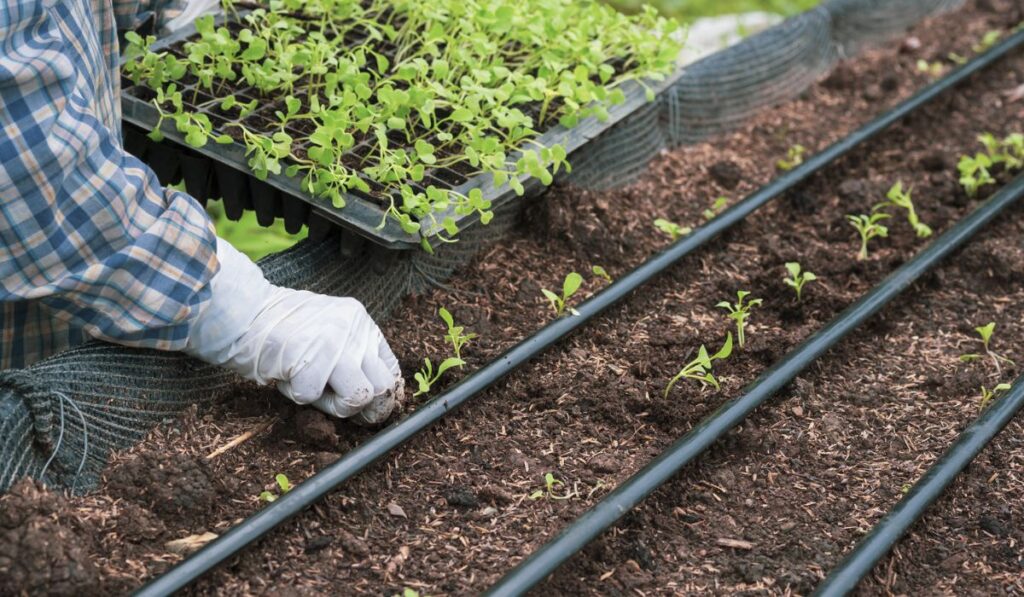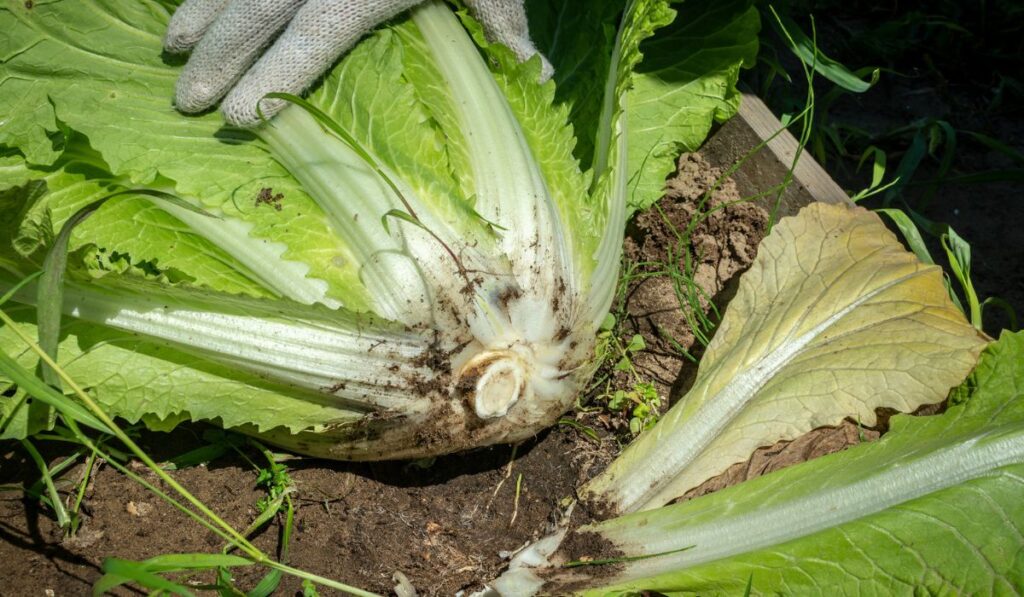Napa Cabbage, also known as Chinese cabbage, is a popular plant for vegetable gardens. It comes in a range of varieties, tastes great in fresh salads, and is a key component of classic dishes like kimchi and gyoza. But is it easy to grow?
Napa cabbage is a fast-growing plant and will be ready for harvest in around three months at most. It grows best in early spring or late summer when the temperature is cooler, and it prefers semi-shade. However, it’s less hardy than other plants, so take care to protect it from disease and pests.
Growing napa cabbage isn’t challenging, but the plants do need to live under particular conditions to flourish. Let’s take a detailed look at napa cabbage varieties, when to plant it, and how to properly maintain a healthy crop.
What Are the Types of Napa Cabbage?
Napa cabbage is categorized into four varieties, each with a slightly different growth pattern. Some types have better disease resistance, while others grow a bit faster, making them ideal for cooler weather.
The four types of napa cabbage you can grow include:
- Rubicon: This is the most popular type of Chinese cabbage and also one of the easiest to grow. It produces standard-size cabbages.
- Blues: This variety is ideal for beginner gardeners, and its slow bolting ability makes it perfect for home cultivation.
- Scarlette: As the name suggests, it produces cabbages with a slight purple shade and can add color to your dishes.
- Minuette: This variety produces slightly smaller cabbages and is ideal for fresh salads and a range of other raw dishes.
All these varieties grow in a similar climate, although the Minuette can grow in slightly colder regions and is resistant to downy mildew. If you have a problem with diseases affecting your cabbages, you can grow the disease-resistant Blues variety.
When Should You Plant Napa Cabbage?

The best time to plant napa cabbage is in the spring when the weather is cooler, because they don’t grow well in hot weather. However, this will often depend on the variety you’re cultivating and the climate in your region.
If you’re planting the Minuette variety, which is slightly more resistant to cold weather, you can plant it in early spring. Other varieties can also be planted in early spring, but try to plant them after any late frosts. The seedlings should develop in cooler weather, and the cabbages will grow rapidly as the weather warms up.
When you plant napa cabbage in early spring, you can expect an early summer harvest. You can plant them in full sunlight in early spring, and this should accelerate their growth.
Napa cabbage can also be planted in the summer for a late fall harvest. Many people plant their first batch in early spring and harvest it in early summer. Doing so gives you enough time to get a second batch of napa cabbage before winter.
When planting napa cabbage in summer, you’ll have to place them in a semi-shaded area and take care that they don’t dry up. While they do grow in hotter weather, the ideal growing temperature is between 50 and 80 F.
Tips on Sowing Napa Cabbage
While napa cabbage isn’t particularly sensitive, they aren’t as hardy as many vegetable plants and require proper care to flourish. When sowing napa cabbage, you’ll have to consider the soil quality and pH and ensure proper spacing between the plants.
Follow these steps when sowing napa cabbage:
Prepare the Soil
Napa cabbage retains a lot of water and needs moist soil for optimal growth. Make sure the soil is well worked and has good drainage. Napa cabbage doesn’t grow well in dry or clay soil, so try sowing them in a raised bed if your garden’s soil isn’t ideal.
Also, make sure the soil’s pH is between 6.0 and 7.5. You can grow them in slightly acidic or basic soil, but they will grow best in neutral soils.
Choose a Spot With Partial Shade
Napa cabbage requires around five to eight hours of full sunlight to grow, although you can grow them in areas with more shade. Choose a spot in your garden that gets partial sun before planting the seeds.
Plant From Seeds or Seedlings
Once you’ve prepared the growing spot, you’ll have to consider whether you want to plant them from seeds or seedlings. If you’re planting in early spring, it’s best to grow the seedlings indoors for about two weeks before moving them outdoors.
If you’re planting napa cabbage in warmer weather, you can plant the seeds directly outdoors. The seeds will germinate in around four to seven days.
Space the Plants Properly
When you’re sowing napa cabbage seeds, plant them around a quarter-inch deep and 12 to 18 inches apart. You can give less space between the seeds if you plan to relocate them later. However, if you’re planting seeds or seedlings directly, space them properly to accommodate future growth.
Protect the Seedlings With Fabric Row Covers
Napa cabbage will attract a lot of pests, so it’s important to protect the seedlings after sowing them. You can use fabric row covers (on Amazon) to prevent most pests from eating young plants. You can also use a herbicide, but try to use one that has an organic formula.
Caring for Your Napa Cabbage
Napa cabbage isn’t particularly difficult to grow but isn’t a hardy plant and requires care to cultivate. These plants will wilt and die if the weather is too hot or cold, and they are vulnerable to pests and diseases.
Here are factors you should keep in mind when growing napa cabbage:
Keep an Eye on Your Napa Cabbage’s Sun Exposure
Napa cabbage needs at least four hours of direct sunlight to grow, but not more than eight. If the weather is too hot and the leaves start drooping, try covering them for an hour or two or relocate them to a semi-shaded area of your garden.
Water Your Napa Cabbage Regularly
Napa cabbage needs to be watered regularly, and the soil should remain moist but well-drained. If your cabbage plant is in a semi-shaded area, watering it once a week is enough. However, if the weather is hotter or the plant is in full sun, you may have to water it more often.
To check whether your plants need water, make a half-inch hole in the ground around the cabbage. If you go more than half an inch deep and the soil is still dry, you should water the plant.
Follow best gardening practices when watering napa cabbage and try to water it in the early morning or evening.
Add Fertilizer Sparingly
Napa cabbage grows in nutrient-rich soil, but it doesn’t need extra fertilizer to grow. You’ll only need to add compost or fertilizer once, about one month after planting. Try using compost or a pH-neutral fertilizer for balanced soil.
Monitor the Temperature Carefully
Napa cabbage won’t instantly wither and die when the temperature increases, but it will affect the plant’s growth. If the temperature becomes too hot, shade them for a few hours in the daytime and water them more regularly.
If you live in a cooler area, cover the napa cabbage seedlings with mulch to protect them from late frosts and prevent them from bolting. You can also plant bolting-resistant varieties in such climates.
How to Harvest Napa Cabbage

For loose leaf cabbage types, you can pull off the leaves when they reach full size. If you want to keep the plant fresh, you can pull off a layer of leaves at a time and only pull out the whole plant when there aren’t any leaves left.
For other varieties, you’ll have to squeeze the cabbage head gently to feel whether it’s ready for harvest. If the head gives in easily, the cabbage isn’t ready. If it has a slight give, you can harvest it.
You’ll have to check each cabbage before harvesting it since plants that were grown simultaneously may mature at different times. Also, don’t wait for your napa cabbage to reach “full size” before harvesting it. You may sometimes get smaller cabbages and even variations in size in a single crop.
